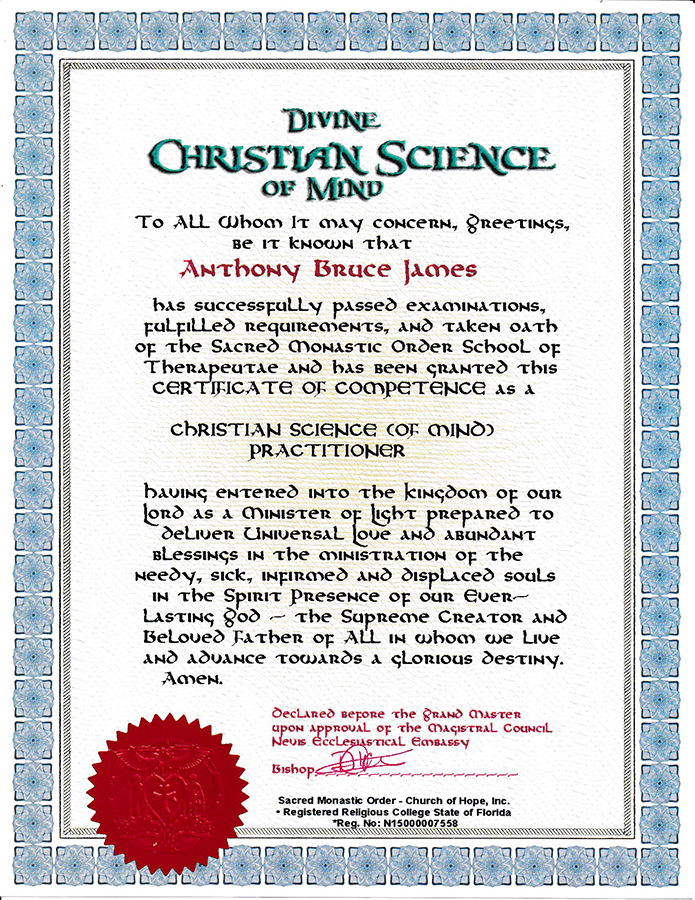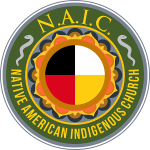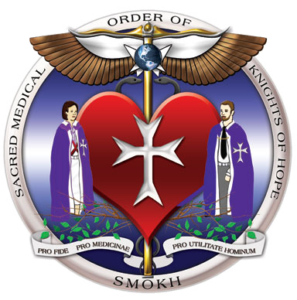Tenants of Monastic Biological Christian Science
Tenants of Monastic Biological Christian Science as adopted by NAIC
What We Believe

Christian Monastic Biological Science has its main tenets that summarize its core beliefs and teachings:
The Native American Indigenous Church formally integrates and adopts the teachings and practices of Christian Science as a vital part of our religious therapeutic sacramental duties of expression.
CHRISTIAN SCIENCE PRACTITIONER: Dr. Anthony B. James and Dr. Julie James

HSA and IRS Deductible Medical Expenses. See Christian Science Practitioner Services available- HSA Authorized- IRS 502(2024) Medical and Dental Expenses
1. The Bible is regarded as the inspired Word of God and serves as the sufficient guide to eternal Life.
2. Acknowledgment and adoration of one supreme and infinite God, along with His Son (Christ), the Holy Ghost (divine Comforter), and man created in God’s image and likeness.
3. We recognize Jesus as the Way-shower, his role as a spiritual guide and exemplar for humanity, demonstrating the path to God and living a life aligned with divine principles.
4. Recognition of God’s forgiveness through the observations of the health laws as found in the Bible and the spiritual understanding that we maintain hygiene and cast out defilement as sin, and we are punished as long as these practices persist.
5. The biblical understanding of hygiene encompasses physical cleanliness and spiritual purity. In the Old Testament, particularly in Leviticus, detailed instructions for maintaining cleanliness serve both health and religious purposes. These include practices such as bathing, washing clothes, and proper waste disposal. Furthermore, the New Testament presents the concept of washing as a metaphor for spiritual cleansing, extending beyond mere physical hygiene but also concomitant spiritual purity and the concept of the body as our temple of the Holy Spirit. This holistic approach goes beyond the notion of removing defilement and includes active practices to maintain physical health, hygiene, and spiritual well-being.
6. In the simple, direct words of Genesis, the cause of all cosmic events is ascribed to the all-powerful godly command: “He speaks, and so it comes to pass; He commands, and so it is,” what we call the Breath of God. In the primeval myths, the creation of the world is traced back to the magic effect of the powerful letters of The Holy Name. “In the Beginning, God created the Heavens and the Earth.”
7. In ancient Greek thought, pneuma (πνεῦμα) is a term that carries rich meaning, often translated as “breath,” “spirit,” or “wind”. The term “pneuma” appears 24 times in the Gospel of John alone. It is a Greek word that corresponds to the Hebrew “ruah,” and both are used to refer to concepts of spirit, wind, aether, and breath in Christian scripture.
8. Pneuma is closely associated with the divine and the creation of life providing the energy to spin the atom; and in the biologic world appears as Mych. the primary nucleus that forms within the first cell, the process of the manifestation of mych from the spirit world evolves into the physical formation of protits, tiniest colloids of life proteins, sized between 1 and 10 nm, of plant origin, the vital basis of all cellular life on planet Earth.
9. We believe the breath of God, through luminiferous aether, once hovered over the lifeless void, animating the dark waters and catalyzing life where there was none. This concept aligns with many creation narratives where a divine breath is instrumental in bringing the world into existence. This divine breath in our religious and philosophical contexts, is pneuma and understood as the life-giving force that animates and sustains living beings and is linked to the Holy Spirit, the third person of the Trinity. In the Hebrew Bible, it is related to the breath of life (nĕshamah) that God breathes into Adam, bringing him to life.
10. Marcus Terentius Varro (116–27 BCE), Günther Enderlein, Gaston Naessens, Wilhelm Reich, Raymond Royal Rife, and Antoine Béchamp all wrote about theories about microscopic life forms in the body, which have been given various names:
• minute creatures: Marcus Varro wrote about which “cannot be seen by the eyes, but which float in the air and enter the body through the mouth and nose and cause serious diseases”.
• “molecular granulations” in biological fluids were actually the elementary units of life. Bechamp named them microzymas—that is, “tiny enzymes”—and credited them with producing both enzymes which ferment and cells while “evolving” amid favorable conditions into multicellular organisms. Béchamp discovered they exist everywhere, stones, fossils, and organic matter; are indestructible and omnipotent in nature; also denied that bacteria could invade a healthy animal and cause disease, claiming instead that unfavorable host and environmental conditions first destabilize the host’s native microzymas and decompose host tissue and thereby produce pathogenic bacteria and also make one prone to infection.
• Protits: Tiny colloids of proteins, sized between 1 and 10 nm, considered the smallest particles in Enderlein’s theory of life origin which appears and disappears “like lightning.” Enderlein also claimed like Bechamp tthat unfavorable host and environmental conditions first destabilize the host’s native microzymas and decompose host tissue and thereby produce pathogenic bacteria and also make one prone to infection.
• “nanobacteria”: Raymond Royal Rife reported observing tiny, motile entities he named “BX” or “cancer virus” after culturing cancer tissues using specific methods. Rife wrote about ultramicroscopic organisms, he claimed to have observed and studied extremely small microorganisms that were invisible under conventional microscopes of his time.
• Wilhelm Reich described bions as minute vesicles that exhibited properties such as pulsation, locomotion, and internal vibration. He observed these bions using high-powered microscopes with over 3000x magnification. Reich’s research on bions led him to explore their potential role in the origin of life and their relationship to cancer cells.
11. We claim and believe that Life is in the Blood. That the endobiont of Bechamp, Enderlein, and Reich resides in the blood as vital to the host, and unfavorable host and environmental conditions first destabilize the host’s native microzymas (life giving enzymes) and decompose host tissue and thereby produce pathogenic bacteria and also make one prone to infection.
These tenets reflect our Christian Monastic Medical Science’s unique interpretation of Christianity, emphasizing spiritual healing and the belief in the illusory nature of the material world and one God who eternally exists as three distinct persons: the Father, the Son, and the Holy Spirit. This mystery of God’s triune nature is central to Christian theology and worship.
We affirm the principles and therapeutic practices of Christian Science are cogent and in harmony with traditional native american indigenous religious expression, beliefs and practices of healing ritual and suitable for all NAIC Members.
Resources:
- Monastic Medicine as a 21st. Century School & Modality: Dr. Charles McWilliams
- Christian Monastic Medical Science Manifesto of the Sacred Medical Order, St. John of St. Christopher & Nevis
- Monastic Medicine: An Intangible Cultural Heritage: https://nativefirechurch.org/tenants-of-monastic-biological-christian-science/
- Christian Monasticism: https://en.wikipedia.org/wiki/Christian_monasticism
- Three Spirit, Mind and Body: The Archaeology of Monastic Healing: https://www.cambridge.org/core/services/aop-cambridge-core/content/view/2BECA8DA7A515729B759DD5757EC1C0D/9781108496544c3_71-109.pdf/spirit_mind_and_body_the_archaeology_of_monastic_healing.pdf
- The Medical Role of Monasteries in the Latin West, c. 1050–1300: https://www.cambridge.org/core/books/abs/cambridge-history-of-medieval-monasticism-in-the-latin-west/medical-role-of-monasteries-in-the-latin-west-c-10501300/0356126BD47F0EE7E7682DD4FD2A898E
- Medicine and Health Care in Early Christianity: https://pmc.ncbi.nlm.nih.gov/articles/PMC6027019/
- Christianism and society in Late Antiquity: A research Bibleography Compendium: https://aiep-iaps.org/taxonomy/term/6
- Christian Science: https://www.christianscience.com/
- Christian Science Religious Denomination: https://www.britannica.com/topic/Christian-Science


